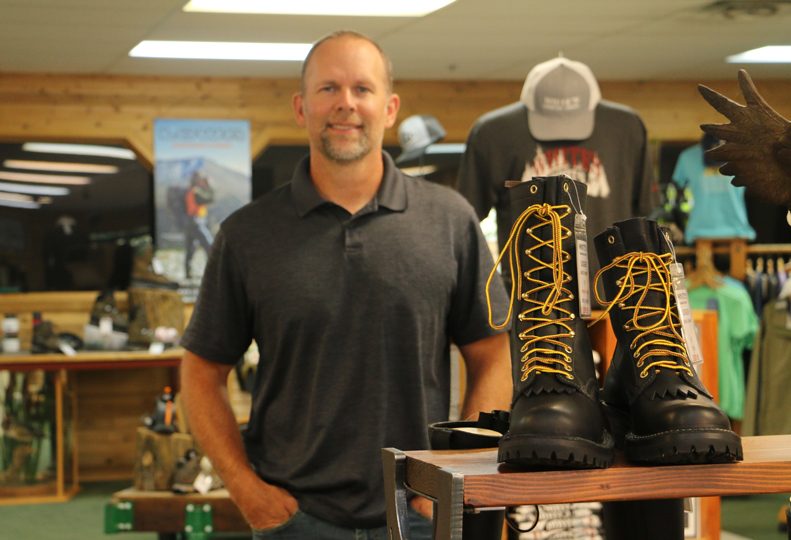
Home » White's Boots kicks it up a notch
White's Boots kicks it up a notch
Spokane bootmaker expects to grow via new lifestyle markets, CEO says

August 13, 2020
White’s Boots Inc. is diversifying its product offerings with the goal of appealing to a wider clientele.
Located at 4002 E. Ferry in East Spokane, the company makes rugged boots worn by wildland firefighters, loggers, and linemen: sturdy calf-height leather boots with thick soles and high heels, meant to protect feet from hazards such as smoldering hot spots.
Eric Kinney, president and CEO of White’s Boots, says he hopes the company’s expansion into other kinds of boots will entice new customers to the brand.
“Our No. 1 business has always been in wildland firefighting,” Kinney says. “We’re trying to expand into lifestyle boots now, more high-end footwear.”
For the past four years, White’s also has made boots its website says are for “field, town, and road,” in styles from glossy leather military police-inspired ankle boots, to hardy buckled motorcycling boots, to low-heeled chukka boots named for Kinney, who designed them.
Boots range in price from $369 for a pair of Kinney Chukkas to $639 for the Lineman Pro boot, made specifically for linemen.
“We envision the average hard-working guy to wear White’s work boots to work, wear White’s hunting boots on the weekend, and have the choice to dress up and wear White’s to a formal occasion,” Kinney says.
Kinney says White’s is focusing on expanding its lifestyle boots lines, with the addition of a line of hunting boots that White’s introduced last month.
Part of the reason for adding lifestyle boots, Kinney says, is that White’s has seen an increase in competitors that make boots for wildland firefighting. But White’s also wants to capture a larger part of the footwear market that it had previously neglected.
“It’s tough to be something to everyone, but as an American-made company, we need to diversify our product offerings to hit as many new consumers as possible,” Kinney says.
When White’s decided to launch hunting boots, Kinney says the company chose to work with an Italian company to design the boots in order to offset some of the cost of production — making boots is more expensive to do in the U.S. due to comparatively high employee wages and challenges in sourcing raw materials, Kinney claims. He says making boots in the U.S. costs twice the amount it costs to make boots in Europe.
“To grow the company, we need about 25% of sourced product,” Kinney says. “Most of the big footwear companies are sourcing 50% to 100% of their product. I’m sure there will be some negative feedback on the Italian-sourced boots not being made in America, but I think the average White’s customer will like the products.”
White’s is far from abandoning its mainstay lines of work boots, however. Kinney says the company is preparing to launch a new firefighting boot in January that he hopes will appeal to younger firefighters. With its low heel, cushioned insole, and sleeker design, Kinney says the Fire Hybrid is a mix of characteristics of Italian-style boots and White’s traditional firefighting boots.
“A lot of firefighters have gone to an Italian brand because they’re low heeled and more comfortable to start — ours take about 80 to 100 hours to break in,” Kinney says.
Kinney is well-versed in boots — he’s been working for White’s Boots for 32 years, 26 years of which he spent making boots on the company’s production floor.
“For almost all of the history of White’s but maybe six or seven years, a bootmaker has run the business,” Kinney says.
Kinney took the helm last year, succeeding his stepfather, Gary March, as president and CEO. Shortly after joining the C-suite, Kinney brought on a creative director to handle social media and a marketing manager to increase the company’s reach. White’s launched a new website about six months ago, Kinney says.
At its 42,000-square-foot manufacturing facility, which includes an 8,000-square-foot retail space, White’s cobbles 40,000 pairs of boots a year from 400,000 square feet of leather. Kinney says the company’s annual revenue is “just shy” of $12 million.
Kinney says White’s had to lay off 20 of its 90 employees early in the year due to the coronavirus pandemic, but most of those employees have been hired back. He says White’s applied for a Paycheck Protection Program loan, but was denied because its parent company is too large. White’s was sold in 2014 to Portland-based LaCrosse Footwear.
Kinney says that like most online retailers, White’s online orders have been robust this year.
“It was the perfect storm,” Kinney says. “People had to be at home. They couldn’t do much, plus they had stimulus money, plus maybe the extra $600 in unemployment money every week. We’re doing a little bit better than our forecasted sales, especially for the last three months.”
Kinney declines to disclose sales figures.
The history of White’s Boots stretches back more than a century—and across a continent. Company founder Otto White began making boots in West Virginia, where his father and grandfather had made boots for loggers. In 1902, White moved the company to St. Maries, Idaho, before moving White’s Boots to Spokane in 1915. Otto was active in the company until his death in 1972.
The company is embedding White’s products with Spokane references, as an homage to the city the company has called home for the past 105 years.
“We are trying to name most of our lifestyle boots and new work boots after Spokane city streets,” Kinney says. “The Main St. boots and Stevens St. boots were named after the corner that the old White’s was on in downtown Spokane until 1970.”
In September, White’s is launching a moc toe boot that will be called the Perry, after Spokane’s Perry District.
Latest News Up Close Retail Manufacturing
Related Articles
Related Products

![Brad head shot[1] web](https://www.spokanejournal.com/ext/resources/2025/03/10/thumb/Brad-Head-Shot[1]_web.jpg?1741642753)


